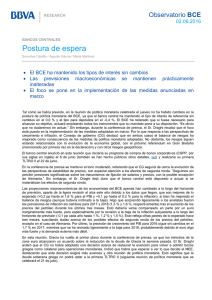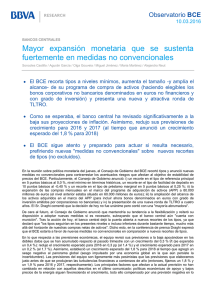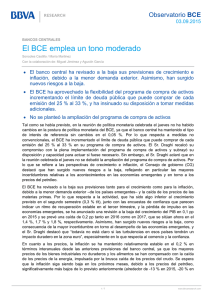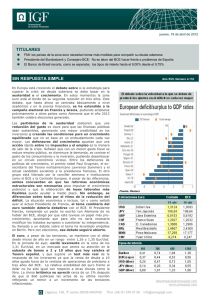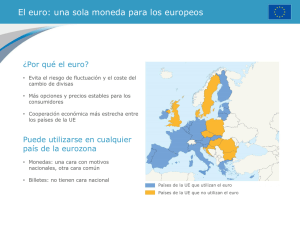CENTRAL BANKS - BBVA Research
Anuncio
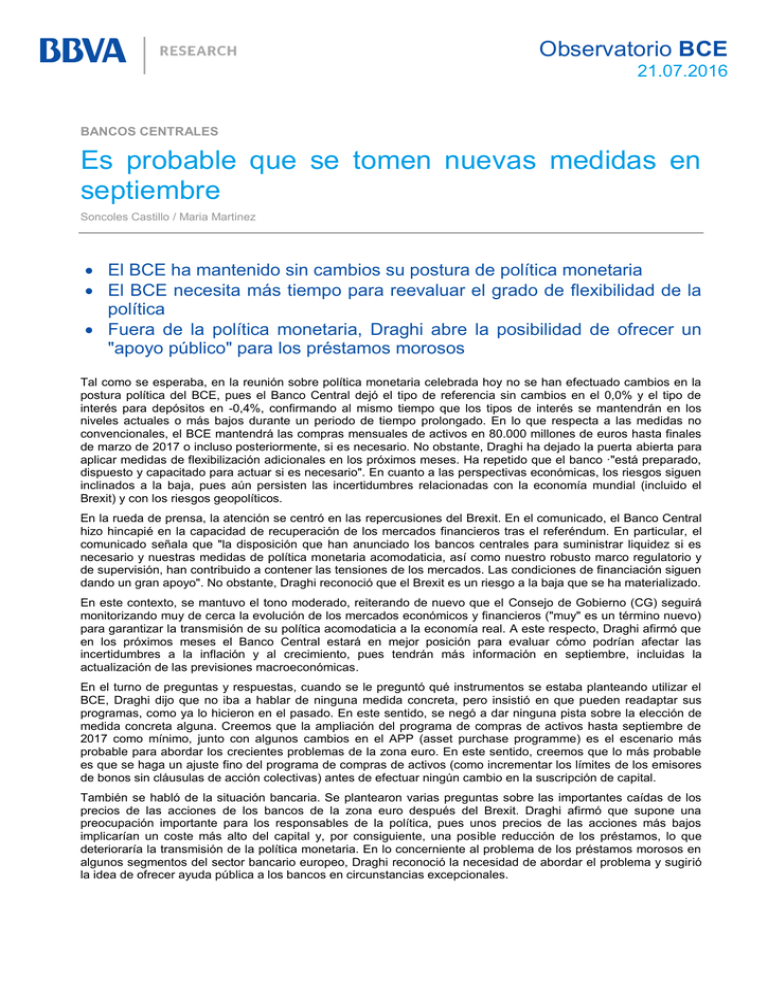
Observatorio BCE 21.07.2016 BANCOS CENTRALES Es probable que se tomen nuevas medidas en septiembre Soncoles Castillo / Maria Martinez El BCE ha mantenido sin cambios su postura de política monetaria El BCE necesita más tiempo para reevaluar el grado de flexibilidad de la política Fuera de la política monetaria, Draghi abre la posibilidad de ofrecer un "apoyo público" para los préstamos morosos Tal como se esperaba, en la reunión sobre política monetaria celebrada hoy no se han efectuado cambios en la postura política del BCE, pues el Banco Central dejó el tipo de referencia sin cambios en el 0,0% y el tipo de interés para depósitos en -0,4%, confirmando al mismo tiempo que los tipos de interés se mantendrán en los niveles actuales o más bajos durante un periodo de tiempo prolongado. En lo que respecta a las medidas no convencionales, el BCE mantendrá las compras mensuales de activos en 80.000 millones de euros hasta finales de marzo de 2017 o incluso posteriormente, si es necesario. No obstante, Draghi ha dejado la puerta abierta para aplicar medidas de flexibilización adicionales en los próximos meses. Ha repetido que el banco ·"está preparado, dispuesto y capacitado para actuar si es necesario". En cuanto a las perspectivas económicas, los riesgos siguen inclinados a la baja, pues aún persisten las incertidumbres relacionadas con la economía mundial (incluido el Brexit) y con los riesgos geopolíticos. En la rueda de prensa, la atención se centró en las repercusiones del Brexit. En el comunicado, el Banco Central hizo hincapié en la capacidad de recuperación de los mercados financieros tras el referéndum. En particular, el comunicado señala que "la disposición que han anunciado los bancos centrales para suministrar liquidez si es necesario y nuestras medidas de política monetaria acomodaticia, así como nuestro robusto marco regulatorio y de supervisión, han contribuido a contener las tensiones de los mercados. Las condiciones de financiación siguen dando un gran apoyo". No obstante, Draghi reconoció que el Brexit es un riesgo a la baja que se ha materializado. En este contexto, se mantuvo el tono moderado, reiterando de nuevo que el Consejo de Gobierno (CG) seguirá monitorizando muy de cerca la evolución de los mercados económicos y financieros ("muy" es un término nuevo) para garantizar la transmisión de su política acomodaticia a la economía real. A este respecto, Draghi afirmó que en los próximos meses el Banco Central estará en mejor posición para evaluar cómo podrían afectar las incertidumbres a la inflación y al crecimiento, pues tendrán más información en septiembre, incluidas la actualización de las previsiones macroeconómicas. En el turno de preguntas y respuestas, cuando se le preguntó qué instrumentos se estaba planteando utilizar el BCE, Draghi dijo que no iba a hablar de ninguna medida concreta, pero insistió en que pueden readaptar sus programas, como ya lo hicieron en el pasado. En este sentido, se negó a dar ninguna pista sobre la elección de medida concreta alguna. Creemos que la ampliación del programa de compras de activos hasta septiembre de 2017 como mínimo, junto con algunos cambios en el APP (asset purchase programme) es el escenario más probable para abordar los crecientes problemas de la zona euro. En este sentido, creemos que lo más probable es que se haga un ajuste fino del programa de compras de activos (como incrementar los límites de los emisores de bonos sin cláusulas de acción colectivas) antes de efectuar ningún cambio en la suscripción de capital. También se habló de la situación bancaria. Se plantearon varias preguntas sobre las importantes caídas de los precios de las acciones de los bancos de la zona euro después del Brexit. Draghi afirmó que supone una preocupación importante para los responsables de la política, pues unos precios de las acciones más bajos implicarían un coste más alto del capital y, por consiguiente, una posible reducción de los préstamos, lo que deterioraría la transmisión de la política monetaria. En lo concerniente al problema de los préstamos morosos en algunos segmentos del sector bancario europeo, Draghi reconoció la necesidad de abordar el problema y sugirió la idea de ofrecer ayuda pública a los bancos en circunstancias excepcionales. Observatorio BCE 21.07.2016 En definitiva, consideramos que es muy probable que el BCE tome algunas medidas adicionales en septiembre, pero no medidas radicales. Aunque Draghi no ha dado pistas claras sobre la elección de ninguna medida en particular, la ampliación del programa de compras de activos podría ser una de las opciones preferidas en combinación con el ajuste fino de los parámetros del mismo. Observatorio BCE 21.07.2016 DESTACADO: sobre el formato del comunicado del BCE: El aparente formato “control de cambios” que se emplea a continuación tiene por objeto facilitar el seguimiento de cambios del comunicado respecto a la anterior reunión del BCE. En negro aparece la parte del comunicado que se mantiene sin cambios. En azul y subrayado las novedades de la última reunión y en rojo y tachado, el texto que no aparece en el nuevo comunicado Mario Draghi, President of the ECB, Vítor Constâncio, Vice-President of the ECB, Ewald Nowotny, Governor of Oesterreichische Nationalbank, Vienna, 2 JuneFrankfurt am Main, 21 July 2016 Ladies and gentlemen, the Vice-President and I are very pleased to welcome you to our press conference. I would like to thank Governor Nowotny for his kind hospitality and express our special gratitude to his staff for the excellent organisation of We will now report on the outcome of today’s meeting of the Governing Council. We will now report on the outcome of our meeting, which was also attended by the Commission Vice-President, Mr Dombrovskis. Based on our regular economic and monetary analyses, we decided to keep the key ECB interest rates unchanged. We continue to expect them to remain at present or lower levels for an extended period of time, and well past the horizon of our net asset purchases. Regarding non-standard monetary policy measures, we confirm that the monthly asset purchases of €80 billion are intended to run until the end of March 2017, or beyond, if necessary, and in any case until the Governing Council sees a sustained adjustment in the path of inflation consistent with its inflation aim. As a next step, on 8 June we will start making purchases under our corporate sector purchase programme (CSPP). Moreover, starting on 22 June, we will conduct the first operation in our new series of targeted longer-term refinancing operations. Further information on implementation aspects of the CSPP will be released after the press conference on the ECB’s website. The comprehensive package of decisions takenToday we discussed developments since our last monetary policy meeting in early March underpins the momentumJune. Following the UK referendum on EU membership, our assessment is that euro area financial markets have weathered the spike in uncertainty and volatility with encouraging resilience. The announced readiness of central banks to provide liquidity, if needed, and our accommodative monetary policy measures, as well as a robust regulatory and supervisory framework, have all helped to keep market stress contained. Financing conditions remain highly supportive, which contributes to a strengthening in credit creation. They continue to support our baseline scenario of the euro area’san ongoing economic recovery and fosters the return of an increase in inflation to levels below, but close to, 2%. In particular, our measures continue to easerates. At the same time, given prevailing uncertainties, the cost of credit and contribute to a strengthening in credit creation. The Governing Council will continue to monitor economic recovery is gradually proceeding. Additional stimulus, beyondand financial market developments very closely and to safeguard the impetus already taken into account, is Observatorio BCE 21.07.2016 expected from the monetary policy measures still to be implemented and will contribute to further rebalancing the risks pass-through of its accommodative monetary policy to the outlook for growth and real economy. Over the coming months, when we have more information, including new staff projections, we will be in a better position to reassess the underlying macroeconomic conditions, the most likely paths of inflation. In the current context, it is crucial to ensure that the very low inflation environment does not become entrenched in second-round effects on wage and price setting. The Governing Council will closely monitor the evolution of the outlook for price stability and, if and growth, and the distribution of risks around those paths. If warranted to achieve its objective, the Governing Council will act by using all the instruments available within its mandate. Let me now explain our assessment in greater detail, starting with the economic analysis. Euro area real GDP increased by 0.56%, quarter on quarter, in the first quarter of 2016, after 0.34% in the last quarter of 2015. Growth continues to be supported by domestic demand, while being dampened by weak exports. The latestexport growth has remained modest. Incoming data point to ongoing growth in the second quarter of 2016, though possibly at a lower rate than in the first quarter. Looking ahead, we continue to expect the economic recovery to proceed at a moderate but steady pace. Domestic demand remains supported by the pass-through of our monetary policy measures to the real economy. Favourable financing conditions and improvements in corporate profitability continue to promote a recovery in investment. Moreover, sustainedSustained employment gains, which are also benefiting from past structural reforms, and still relatively low oil prices provide additional support for households’ real disposable income and thus for private consumption. In addition, the fiscal stance in the euro area is slightlyexpected to be mildly expansionary. However, in 2016 and to turn broadly neutral in 2017 and 2018. At the same time, headwinds to the economic recovery in the euro area continues to be dampened byinclude the outcome of the UK referendum and other geopolitical uncertainties, subdued growth prospects in emerging markets, the necessary balance sheet adjustments in a number of sectors and a sluggish pace of implementation of structural reforms. Against this background, the risks to the euro area growth outlook remain tilted to the downside. This outlook is broadly reflected in the June 2016 Eurosystem staff macroeconomic projections for the euro area, which foresee annual real GDP increasing by 1.6% in 2016 and 1.7% in 2017 and 2018. Compared with the March 2016 ECB staff macroeconomic projections, the outlook for real GDP growth has been revised up for 2016 and has remained broadly unchanged for 2017 and 2018. The risks to the euro area growth outlook remain tilted to the downside, but the balance of risks has improved on the back of the monetary policy measures taken and the stimulus still in the pipeline. Downside risks continue to relate to developments in the global economy, to the upcoming British referendum and to other geopolitical risks. According to Eurostat’s flash estimateEurostat, euro area annual HICP inflation in MayJune 2016 was -0.1%, up from 0.21% in AprilMay, mainly reflecting higher energy and services price inflation. Looking ahead, on the basis of current futures prices for oil, inflation rates are likely to remain very low or negative in the next few months before pickingstarting to pick up later in the second half of 2016, in large part owing to base effects in the annual rate of change of energy prices. Supported by our monetary policy measures and the expected economic recovery, inflation rates should recoverincrease further in 2017 and 2018. Observatorio BCE 21.07.2016 This broad pattern is also reflected in the June 2016 Eurosystem staff macroeconomic projections for the euro area, which foresee annual HICP inflation at 0.2% in 2016, 1.3% in 2017 and 1.6% in 2018. In comparison with the March 2016 ECB staff macroeconomic projections, the outlook for HICP inflation has been revised slightly up for 2016, reflecting recent oil price increases, and has remained unchanged for 2017 and 2018. Turning to the monetary analysis, broad money (M3) continued to growincrease at a robust pace in AprilMay 2016, with its annual rate of growth standing at 4.69%, after 5.04.6% in MarchApril. As in previous months, annual growth in M3 iswas mainly supported by its most liquid components, with the narrow monetary aggregate M1 growingexpanding at an annual rate of 9.1% in May, after 9.7% in April, after 10.1% in March. Loan dynamics followed the path of gradual recovery observed since the beginning of 2014. The annual rate of change of loans to non-financial corporations (adjusted for loan sales and securitisation) stood atincreased to 1.24% in AprilMay 2016, compared with 1.12% in MarchApril. Developments in loans to enterprises continue to reflect the lagged relationship with the business cycle, credit risk and the ongoing adjustment of financial and non-financial sector balance sheets. The annual growth rate of loans to households (adjusted for loan sales and securitisation) remained broadly stable at 1.6% in May, after 1.5% in April, after 1.6% in March. The euro area bank lending survey for the second quarter of 2016 indicates further improvements in loan supply conditions for loans to enterprises and households and a continued increase in loan demand across all loan categories. Furthermore, banks continued to report that the targeted longer-term refinancing operations had contributed to more favourable terms and conditions on loans. The monetary policy measures in place since June 2014 have clearlysignificantly improved borrowing conditions for firms and households, as well as credit flows across the euro area. The comprehensive package of new monetary policy measures adopted in March this year underpins the ongoing upturn in loan growth, thereby supporting the recovery of the real economy. In the light of the prevailing uncertainties, it is essential that the bank lending channel continues to function well. To sum up, a cross-check of the outcome of the economic analysis with the signals coming from the monetary analysis confirmed the need to preserve an appropriate degree of monetary accommodation in order to secure a return of inflation rates towards levels that are below, but close to, 2% without undue delay. Monetary policy is focused on maintaining price stability over the medium term and its accommodative stance supports economic activity. As emphasised repeatedly by the Governing Council, and as again strongly echoed in both European and international policy discussions, in order to reap the full benefits from our monetary policy measures, other policy areas must contribute much more decisively, both at the national and at the European levels. Structural policies are essential, given continued highlevel. The implementation of structural reformsneeds to be substantially stepped up to reduce structural unemployment and lowboost potential output growth in the euro area. Structural reforms are necessary in all euro area countries, although specific reform needs differ across the individual economies. At this stage, theThe focus should be on actions to raise productivity and improve the business environment, including the provision of an adequate public infrastructure, which are vital to increase investment and boost job creation. The enhancement of current investment initiatives, including the extension of the Juncker plan, and progress on the capital markets union and reforms that will improve the resolution of non-performing loans will also contribute positively to this objective. In an Observatorio BCE 21.07.2016 environment of accommodative monetary policy, the swift and effective implementation of structural reforms, in line with the 2016 country-specific recommendations recently publishedapproved by the European CommissionCouncil, will not only lead to higher sustainable economic growth in the euro area but will also make the euro area more resilient to global shocks. Fiscal policies should also support the economic recovery, while remaining in compliance with the fiscal rules of the European Union. Full and consistent implementation of the Stability and Growth Pact over time and across countries is crucial to maintain confidence in the fiscal framework. At the same time, all countries should strive for a more growthfriendly composition of fiscal policies. Observatorio BCE 21.07.2016 AVISO LEGAL El presente documento, elaborado por el Departamento de BBVA Research, tiene carácter divulgativo y contiene datos, opiniones o estimaciones referidas a la fecha del mismo, de elaboración propia o procedentes o basadas en fuentes que consideramos fiables, sin que hayan sido objeto de verificación independiente por BBVA. BBVA, por tanto, no ofrece garantía, expresa o implícita, en cuanto a su precisión, integridad o corrección. Las estimaciones que este documento puede contener han sido realizadas conforme a metodologías generalmente aceptadas y deben tomarse como tales, es decir, como previsiones o proyecciones. La evolución histórica de las variables económicas (positiva o negativa) no garantiza una evolución equivalente en el futuro. El contenido de este documento está sujeto a cambios sin previo aviso en función, por ejemplo, del contexto económico o las fluctuaciones del mercado. BBVA no asume compromiso alguno de actualizar dicho contenido o comunicar esos cambios. BBVA no asume responsabilidad alguna por cualquier pérdida, directa o indirecta, que pudiera resultar del uso de este documento o de su contenido. Ni el presente documento, ni su contenido, constituyen una oferta, invitación o solicitud para adquirir, desinvertir u obtener interés alguno en activos o instrumentos financieros, ni pueden servir de base para ningún contrato, compromiso o decisión de ningún tipo. Especialmente en lo que se refiere a la inversión en activos financieros que pudieran estar relacionados con las variables económicas que este documento puede desarrollar, los lectores deben ser conscientes de que en ningún caso deben tomar este documento como base para tomar sus decisiones de inversión y que las personas o entidades que potencialmente les puedan ofrecer productos de inversión serán las obligadas legalmente a proporcionarles toda la información que necesiten para esta toma de decisión. El contenido del presente documento está protegido por la legislación de propiedad intelectual. Queda expresamente prohibida su reproducción, transformación, distribución, comunicación pública, puesta a disposición, extracción, reutilización, reenvío o la utilización de cualquier naturaleza, por cualquier medio o procedimiento, salvo en los casos en que esté legalmente permitido o sea autorizado expresamente por BBVA.
